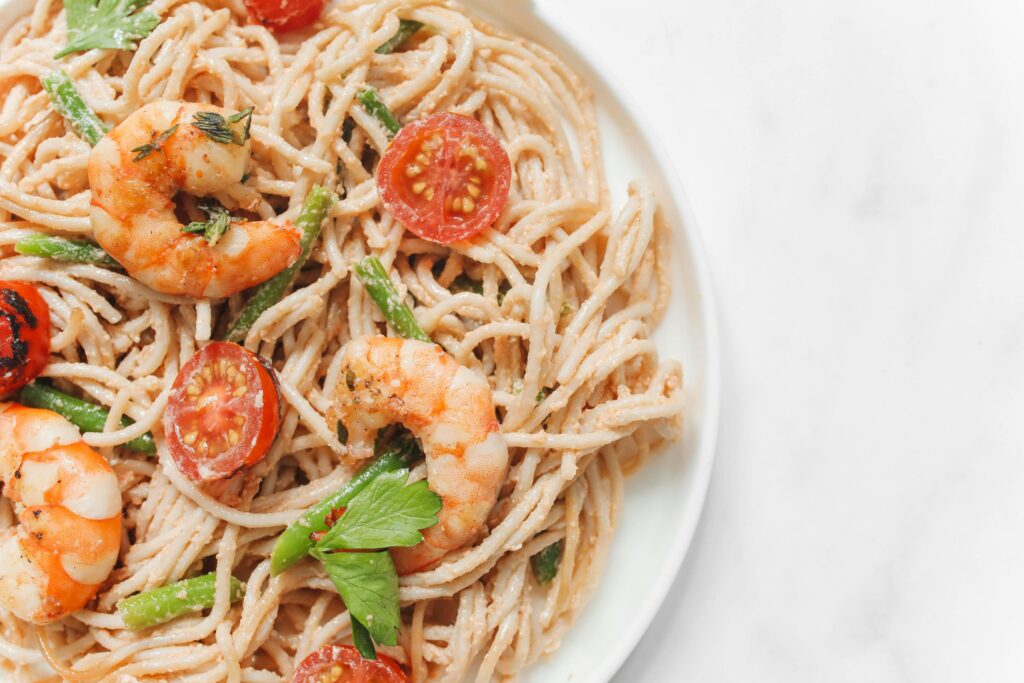
Making fresh pasta at home is a rewarding experience! Here’s a basic guide to get you started:
Ingredients:
- Flour: “00” flour, also called doppio zero, is the traditional choice for pasta due to its fine texture, which creates a smooth and elastic dough. All-purpose flour can also be used, though the pasta might not be quite as smooth. (2 cups / 240 grams)
- Eggs: Use large eggs at room temperature for best results. (3 large eggs)
- Olive Oil (Optional): A tablespoon of olive oil can be added for a richer flavor and slightly smoother dough.
Equipment:
- Large Bowl: For mixing the dough.
- Rolling Pin: For rolling out the pasta dough.
- Sharp Knife: For cutting the pasta.
- Pasta Machine (Optional): A pasta machine makes rolling out the dough much easier and more consistent, but it’s not essential.
Instructions:
- Make a Well: On a clean work surface, create a well with the flour. Crack the eggs into the center of the well.
- Incorporate Gradually: Using a fork, gently beat the eggs and slowly incorporate the flour from the sides of the well, bringing it towards the center.
- Knead the Dough: Once all the flour is incorporated, start kneading the dough. If the dough feels too dry, add a teaspoon of water at a time until it becomes smooth and elastic. Knead for 10-15 minutes by hand, or until the dough is no longer sticky and springs back when gently pressed.
- Rest the Dough: Wrap the dough in plastic wrap and let it rest at room temperature for 30 minutes to an hour. This allows the gluten to relax and makes the dough easier to roll out.
- Roll Out the Dough: Here, the method splits depending on whether you have a pasta machine or not:
- Without a Pasta Machine: Divide the dough into two portions. On a lightly floured surface, use a rolling pin to roll out each portion into a thin sheet, ideally around 1/16 inch (1.5mm) thick. The dough should be translucent when held up to the light.
- With a Pasta Machine: Flatten each dough portion slightly into a disc. Feed it through the widest setting of your pasta machine a couple of times, folding the dough in half after each pass. Gradually decrease the setting on the machine and crank out a long sheet of pasta dough until it reaches the desired thinness (around setting 5 or 6 on most machines).
- Cut the Pasta: There are many shapes you can choose from! Here are a few options:
- Fettuccine: Fold the long pasta sheet in half lengthwise and cut thin strips.
- Tagliatelle: Similar to fettuccine but slightly wider.
- Spaghetti: Keep the pasta sheet flat and cut thin strips.
- Ravioli or Wontons: Cut squares from the pasta sheet, fill them with your desired ingredients, and seal the edges.
- Cook the Fresh Pasta: Bring a large pot of salted water to a boil. Fresh pasta cooks quickly, usually in 2-3 minutes for thin noodles like fettuccine or spaghetti, and a couple of minutes longer for thicker shapes or filled pasta like ravioli.
- Serve and Enjoy!: Drain the cooked pasta and toss it with your favorite sauce, vegetables, or protein. Fresh pasta has a wonderful texture and flavor that’s superior to store-bought dried varieties.
Tips:
- Use high-quality ingredients for the best results.
- Don’t overwork the dough. Knead it until smooth and elastic, but avoid over-kneading, which can make the pasta tough.
- If the dough feels too dry while rolling it out, lightly dust it with flour.
- Fresh pasta doesn’t need to be dried. You can cook it right after cutting.
- Leftover fresh pasta dough can be stored in the refrigerator for a day or two, or frozen for longer storage.
Making homemade pasta is a fun and creative process. Don’t be afraid to experiment with different shapes and fillings! Enjoy the delicious results of your culinary creation.tunesharemore_vert
